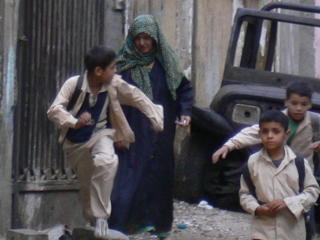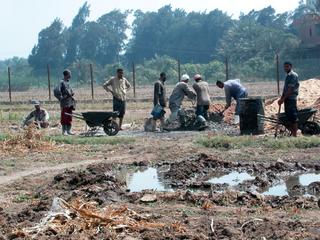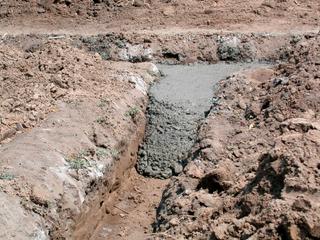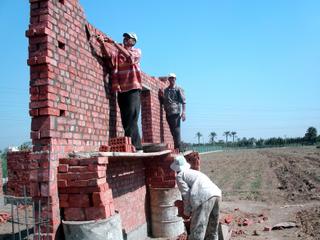
A couple of weeks ago, before the flood from Katrina, before the elections, Tracy and I drove out to Fayoum to join a friend of ours at the Fayoum Pottery School at Ezbat Tounis near Wadi Rayan. Fayoum is an oasis to the southwest of Giza, a depression in the desert that has been connected to the Nile since the time of the pharaohs. During the Greco-Roman period it was heavily inhabited and was an area where grapes for wine were grown. Now there is a large salt lake, Lake Karoun, that is bordered on one side by the agricultural lands and on the other by sandy desert. It's only about an hour and a half from Giza, but for various reasons (none of them that good) I've only gone there a few times in all the time I lived in Cairo.
For a few months now, Tracy and I have been wanting to visit Evelyne's pottery school there, since I've been collecting the handmade tiles that the children produce for use in my kitchen and bathroom on the new land. The children create wonderful whimsical tiles decorated with drawings of the local animals and plants. I've been buying my tiles from Mai Greis who has a gallery on Road 213 in Digla, and it was Mai who we were meeting out in Fayoum.

We set out on a hot August morning and with utter predictability the air conditioning in the jeep died as we drove down the road to the Fayoum highway. So it was open windows all the way and we were very happy to have had the foresight to have brought frozen bottles of water since the breeze was extremely dehydrating. As we entered the valley from Giza (there is another entrance near the Nile at Meidum) we turned towards the lake before we actually came to the city of Fayoum. I had a chance to take some wonderful shots of the farmers plowing their fields with water buffalo and of women and children picking cotton, but like an idiot I thought that we were running late a bit and I would stop on the way out...when naturally it turned out that they'd finished working and were nowhere to be found. Lesson in photography: take the shot when you see it.

Evelyne is Swiss and has been living in Fayoum for about 30 years, the last 28 in the place where the pottery school now exists. You drive along the lake for some time with olive groves on the south and the blue of the lake with its small fishing and sailing boats to the north until you come to the road to Wadi Rayan, a national park with waterfalls. Shortly after turning onto that road, there is another left that takes you on a narrow track through a village that doubles back in the same direction as the lakeside road but higher on the hill. In the midst of the village is the mudbrick entrance to Ezbat Tounis. The grounds of Evelyne's home and the school are on rocky ground. Great slabs of limestone pave the garden and the patios of the house and school and considerable work was necessary to bring in soil for the gardens that are scattered throughout the compound.

All of the construction was done in local mudbrick and plastered with mud mixed with straw in the Fayoumi style, which yeilds a very organic architecture that glows a pale gold in the sun. Evelyne greeted us with Mai and took us to the house where we had some cold water and relaxed in the shade for a bit. For the first twenty years that she lived in the compound they had no electricity and only a handpump for water. Now there is power and running water, and she and her husband Michel (the genius behind Nagada, my favourite Egyptian clothing http://www.nagada.net) even have one of the most lovely and simple swimming pools overlooking the lake. The aura of peace and tranquility that overwhelms the visitor to this wonderful spot is extraordinary.

After cooling off in the shade of Evelyne's kitchen courtyard we went to see the pottery school and the showroom for the work done by the children, men and women who work there. Making our way across the uneven natural limestone carefully, since it was hard to pay attention to the ground with the lush gardens, towering palms, and green lawns all drawing admiring glances, we entered the school compound. The mud brick construction with its thick walls provides efficient insulation and the cool rooms are comfortable places for the potters to work.

A group of children were waiting for Evelyne to inspect their pottery, while one or two were working at the wheels, affording a moment of hilarity when a clot of clay flew off hitting one of the children who was sitting near the potter's wheel in the head. There was no damage other than to dignity and the victim was quickly tidied up. Behind the working area is the handmade kiln where the pots and tiles are fired, while huge vats of clay stand in the courtyard and at one end of the workshop. The brilliance of the natural sunlight is used for the fine decorative work, and the potters sit on stools in the doorways to work. I had purchased a large platter from Mai's shop quite a while ago that depicted the breeding of water buffalo, a somewhat unusual topic for a serving platter. The style of the drawing and its oddity appealed to me at the time and Mai later gave me a companion piece when it came into the shop, saying that I was the only person she knew with a sense of humour warped enough to really appreciate the plate. I met the artist who had drawn these plates and we had a good laugh over them, as he acknowledged that they were not to everyone's taste. He was quite

delighted to meet the crazy lady that he'd heard of who actually enjoyed his gamoosa plates and offered to make me more. I gently declined saying that I had probably quite enough now.
We then went to the more expensive part of the visit and the more stressful...but only in the sense that there were so many wonderful pieces to see and purchase that it was difficult to make up our minds on what we wanted. Across the courtyard from the workshops is a show room that simply takes one's breath away with the array of plates, bowls, cups, tiles, towel racks and so on. Mai was selecting stock for her gallery, while Tracy and I were looking at tiles for accents in our new homes. We probably spent a couple of hours in the showroom pondering pots, contemplating cups, and deliberating over dishes. While we were mulling over the possibilities, some of Evelyne's potters came in to assist her in assembling an order for someone and simply to work in the cool of the showroom.

The display area is open to the courtyard with large arches to let in light and air, no doors here, and one daring sparrow flew in to have a chat with the drawing of a pigeon on a plate that was displayed on a wall. We finally finished our selection, telling each other that now we knew the way there it would be easy to come back for more if necessary. Tracy did order a set of dishes which will probably take a couple of months to finish, but that's fine because so will her house.
After spending a ridiculously small amount on tiles and dishes when one considers the lovely products and what they would cost outside of Egypt, we retired to the poolside for a snack of homemade water buffalo cheese, bread, olives and grapes. Tracy wandered around taking about 150 photos of the landscape, the house and courtyards, the decorations on the buildings, the woodworking, and so on as the style is the sort of thing that we prefer for the building that we will be doing.

There is no way to upload all of those pictures, but I will upload the best to Flickr so that they can be seen there. When I do, I will post the url for everyone to be able to find them.
This is an extraordinary place by any concept. The travel there through the oasis and the desert, the wonderful compound that Evelyne and Michel have built over the years, and the hospitality of our hostess made for a perfect day. Of course the unpredictability of Egypt had to kick in at some point, which it did on the way home when the fuel line in Mai's old VW bug clogged necessitating a stop on the desert highway to Giza. Tracy and I drove on a few kilometres ahead to buy a bit of gas to bring back to Mai and her daughter who were stranded on the roadside and, since we would have had to overshoot their location by a significant amount had we come back on the highway, we opted to drive offroad through the desert amid much laughter and concern for the safety of our pottery in the back of the jeep. We all (even the tiles) arrived in one piece, a friendly mechanic in a taxi stopped by Mai's bug and removed the clog, and we were back on the road home in a short while.
 Horses have a tough enough life in Egypt without angry humans gumming up the works. I've seen the results of people taking human disputes out on animals at some of the Nazlit Semman stables (like those in the photo above), and it isn't pretty.
Horses have a tough enough life in Egypt without angry humans gumming up the works. I've seen the results of people taking human disputes out on animals at some of the Nazlit Semman stables (like those in the photo above), and it isn't pretty.
 Not having the old pipe corrals posed a special problem for me, however. Fares and Bunduq, also known as The Grumpy Old Men, don't really get along that well with the other horses in the paddock. Whatever hopes I had that the new paddock being bigger would make a difference were dashed when Bunduq proceeded to herd the others around by threatening to kick them. However, with a space of about five or six metres between the paddock and the perimeter fence, my builder pointed out that it would be very simple to divide up the 80 metres of the paddock into about 7 smaller paddocks to use as feeding boxes or places to keep horses while we use the paddock for a lesson or something. Woven plastic mats were fixed to the perimeter fence to provide a wind break for Fares in particular.
Not having the old pipe corrals posed a special problem for me, however. Fares and Bunduq, also known as The Grumpy Old Men, don't really get along that well with the other horses in the paddock. Whatever hopes I had that the new paddock being bigger would make a difference were dashed when Bunduq proceeded to herd the others around by threatening to kick them. However, with a space of about five or six metres between the paddock and the perimeter fence, my builder pointed out that it would be very simple to divide up the 80 metres of the paddock into about 7 smaller paddocks to use as feeding boxes or places to keep horses while we use the paddock for a lesson or something. Woven plastic mats were fixed to the perimeter fence to provide a wind break for Fares in particular. Initially the horses reacted to the larger paddock by running around like idiots, but once they got over that, an increased togetherness seemed to be the order of the day. If one of the horses was taken out of the paddock, the entire group followed along the fence line. To try to ease the transition, we decided that we would keep everyone on the property for the next couple of days so that they could get the idea that this was the place that they belonged.
Initially the horses reacted to the larger paddock by running around like idiots, but once they got over that, an increased togetherness seemed to be the order of the day. If one of the horses was taken out of the paddock, the entire group followed along the fence line. To try to ease the transition, we decided that we would keep everyone on the property for the next couple of days so that they could get the idea that this was the place that they belonged. My builder's sons are delighted that the horses have been moved. Ahmed, the younger boy, had been asking to see "Doo" on a daily basis and the two of them come over for a ride on Bunduq at every opportunity. And he's such a good natured old guy, he obliges happily.
My builder's sons are delighted that the horses have been moved. Ahmed, the younger boy, had been asking to see "Doo" on a daily basis and the two of them come over for a ride on Bunduq at every opportunity. And he's such a good natured old guy, he obliges happily.



























